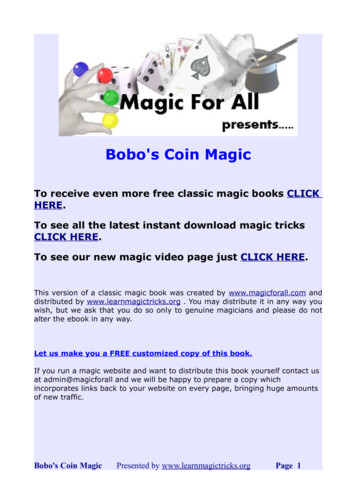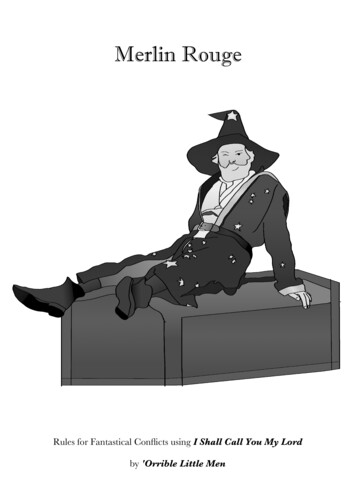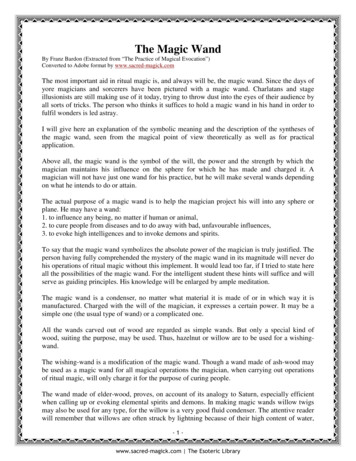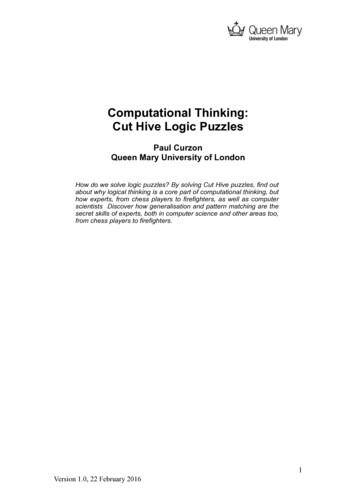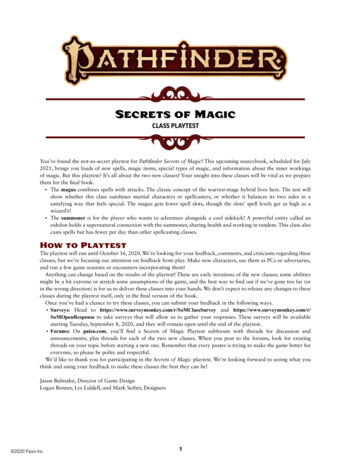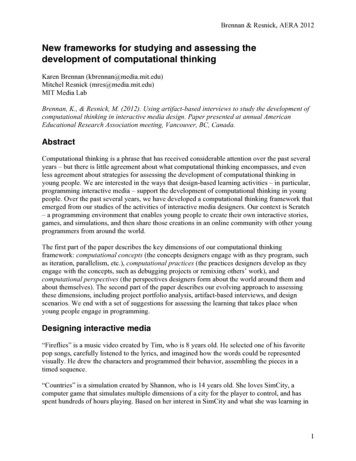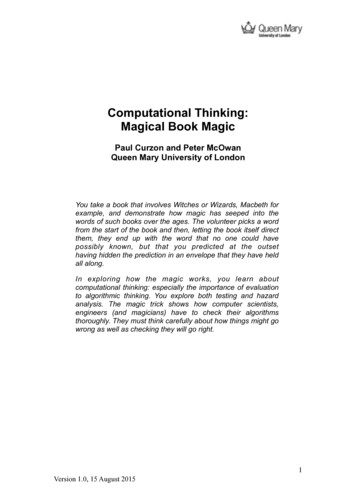
Transcription
!Computational Thinking:Magical Book MagicPaul Curzon and Peter McOwanQueen Mary University of LondonYou take a book that involves Witches or Wizards, Macbeth forexample, and demonstrate how magic has seeped into thewords of such books over the ages. The volunteer picks a wordfrom the start of the book and then, letting the book itself directthem, they end up with the word that no one could havepossibly known, but that you predicted at the outsethaving hidden the prediction in an envelope that they have heldall along.In exploring how the magic works, you learn aboutcomputational thinking: especially the importance of evaluationto algorithmic thinking. You explore both testing and hazardanalysis. The magic trick shows how computer scientists,engineers (and magicians) have to check their algorithmsthoroughly. They must think carefully about how things might gowrong as well as checking they will go right.!1Version 1.0, 15 August 2015
!The MagicYou give a volunteer from the audience a clipboard and pen. On the clipboardare written the opening lines to Shakespeare’s Macbeth, the famous scenewhere the three witches meet. It is a version without any stage direction, justthe words spoken. A dotted line is drawn after the first sentence. The last partof the quotaation is coloured red.When shall we three meet againIn thunder, lightning, or in rain?When the hurlyburly's done,When the battle's lost and won.That will be ere the set of sun.Where the place?Upon the heath.There to meet with Macbeth.I come, Graymalkin!Paddock calls.Anon.Fair is foul, and foul is fair:Hover through the fog and filthy air.Later in the play the witches meet Macbeth and make a prophesy that he willbe King. But words said aloud over and over come to have a magic of theirown. The opening lines of Macbeth have been said so often, that, becausethey are words about magic, those who know how can use them to make theirown predictions.Get three more volunteers to speak aloud the words of the three witches froma book of the play. As they read the words have the first volunteer with the clipboard check that the words on their clipboard are exactly the same words thatthe witches speak. Here are the words as you should find them in a book withthe directions of who speaks what:First WitchWhen shall we three meet againIn thunder, lightning, or in rain?Second WitchWhen the hurlyburly's done,When the battle's lost and won.!2Version 1.0, 15 August 2015
!Third WitchThat will be ere the set of sun.First WitchWhere the place?Second WitchUpon the heath.Third WitchThere to meet with Macbeth.First WitchI come, Graymalkin!Second WitchPaddock calls.Third WitchAnon.ALLFair is foul, and foul is fair:Hover through the fog and filthy air.Now, words spoken, magic swirling through the air, the time is ripe forprediction.Get the volunteer to put their hand on the book of the play and “draw on themagical power that has infused throughout it over the centuries”. Have themthen pick a word from the first sentence of the quotation (before the dottedline), as spoken by the first witch:When shall we three meet againIn thunder, lightning, or in rain?For example, they might choose ‘three’. They should circle their chosen word,telling everyone what it is. Now explain that they are to let the book controlthem. They will jump around the text, guided by the words themselves,allowing the magic of the book to take control. Explain that they should stopthe moment they land on a red word. The red word will be their ultimatechosen word.Explain that to do this they should count the number of letters in the chosenword, and count on that many words to land on a new word and circle it. Forexample, if they chose the word, ‘three’, then it has five letters, so they should!3Version 1.0, 15 August 2015
!count on five words and land on ‘lightning’ which they should circle. Let themdo it with their word, double checking that they haven’t made a mistake.They should do this repeatedly bouncing from word to word, each timecounting the number of letters in the new word and moving on that far. Theyshould ignore punctuation including apostrophes. They should also ignore allthe stage direction in the book version, which is why you’ve given them aversion with only the words spoken.Get them to keep going until they land on a red word for the first time. Theyshould tell everyone what that word is.Once they have landed on a red word, have them agree that it was their ownfree choice of which word to choose, and that they had no idea what wordthey would ultimately land on - no one knew.Now explain that using the magic that is in all books about those who practicemagic, you made a prediction. Point out that there is an envelope on theclipboard under the paper that the volunteer has been writing on. You placed itthere before the trick started. Have them open it. Inside is a piece of paperwith a single word written on it: “HEATH”: which remarkably is also the redword that they ended on. The magic-infused words unlock the power ofprediction.Deeper Magic?Now you know the trick, you can do it yourself, even if you don’t understandhow it works (yet). If you start with the words from Macbeth, it will alwayswork. In fact it is even more magical than that. It will work with just about anybook about witches, wizards or other magic. Try it with the words from thestart of a completely different book: ‘The Wizard of Oz’, for example. Theyare given below.!4Version 1.0, 15 August 2015
!Dorothy lived in the midst of the great Kansas prairies, with UncleHenry, who was a farmer, and Aunt Em, who was the farmer's wife.Their house was small, for the lumber to build it had to be carried bywagon many miles.There were four walls, a floor and a roof, which made one room; andthis room contained a rusty-looking cooking stove, a cupboard for thedishes, a table, three or four chairs, and the beds.Choose a word from the first sentence, follow the same steps again stoppingwhen you first land on a red word in the third sentence. I predict you will havelanded on the word ‘FOUR’.Want more evidence. Try yet another completely different magical book: ‘TheCat in the Hat’ by Dr Seuss. It’s about a magical cat. Don’t trust me to giveyou the words. Go find a copy yourself. Choose a word from the firstsentence. I predict the first word you land on when you get to the secondpage will be “SAT”.The magic is even deeper than that. It will work with just about any writing,though sometimes the sentence to colour red is further on than in others.An algorithmic conspiracy?So is this some powerful, deep magic? Or has their been a conspiracyamongst authors, all sending some kind of coded message? Perhaps it’ssomething to do with the Knight’s Templar, Da Vinci Code like?Actually no. Its just a simple, if at first surprising, computational property ofwords that has been turned in to a magic trick. Magicians call this kind of tricka ‘self-working trick’ because it always works if you follow the steps. You don’thave to know how or why it works to make it work. Just follow the steps andthe magical prediction will be right. Computer Scientists call instructions likethis an algorithm. Algorithms are what computational thinking is all about.The skill of inventing algorithms is called algorithmic thinking. Algorithmsallow us to solve problems without having to think too much. We can justfollow the steps of the algorithm and the right thing happens even if we don’tknow what we are doing or why. That, it turns out, is exactly what we need forcomputers. A computer doesn’t know what it is doing or why. They just followprograms. Programs are just instructions for a computer to follow, written in aspecial language - a programming language suited to the task. They justdescribe algorithms telling a computer how to do useful things. Descriptions ofmagic tricks and programs are essentially the same thing - algorithms. Magictricks describe algorithms for magicians to follow that result in magical effects.!5Version 1.0, 15 August 2015
!Programs describe algorithms for computers to follow that result in wellwhatever the programmer wanted the computer to do.Testing TimesI’ve claimed the trick always works for that passage from Macbeth. Do youbelieve me enough to try the trick for yourself on a live audience? How canyou be sure? Well, you could try it a couple of times. Would that convince youthat it will always work? Does that give you convincing enough evidence?What if they pick a word you didn’t try. You have no idea whether it works forthat one. You will look a bit silly if your prediction turns out to be wrong.There is only one way to be really sure, and it sounds a bit tedious. You haveto check every alternative. You have to be very patient if you are to be a goodmagician or a good computer scientist. Careful checking and attention todetail really, really matters. Programmers call checking programs like this,testing, and more time is normally spent testing new programs than writingthe code in the first place.More generally checking programs are fit for purpose is called evaluation andit is an important part of computational thinking. It is only by the careful anddetailed checking of algorithms that you can be sure they do always work.Doing things carefully and methodically matters. We want to be sure we reallyhave checked all the possibilities. The easiest way to do this for our trick is tostart at the first word, check it works, then move to the next, check it and soon, until we have done them all. We are doing algorithmic thinking again: whatI just described is an algorithm for checking our magic trick works. We canuse algorithmic thinking even when evaluating algorithms! Since we now havean algorithm to do it, we could even write a program based on it to check ourtrick rather than do it by hand. If you can write programs, you might want to tryit. If not, check the magic trick really does always work for Macbeth and theWizard of Oz by hand.We can actually come up with a slightly better algorithm to do the checking,that involves less work. Here is how. If we actually circle each word as thevolunteer did in the actual trick as we check the paths then we can see whichones we have checked already. If we add an arrow showing where we jumpto, we can see the paths we take too. Most of the words bounce us to a newword in the first sentence that could have been chosen as a starting word.When it is their turn to be checked we won’t have to do anything more as wewill already have checked them as part of checking the earlier word.The diagram below shows the result of checking every word from the firstsentence in Macbeth. As part of checking the word ‘when’, for example, webounce to ‘meet’ and then to ‘lightning’. When it is the turn of those words tobe checked we will have nothing more to do as having checked the trickworks for ‘When’ we have already checked those words too as they follow thesame path. With a bit of simple logical thinking we have reduced the numberof paths to check from 12 to only 7, almost halving the work to be done.!6Version 1.0, 15 August 2015
!We can reduce the work needed further still. If at any point a path takes us toa circled word we have already checked then we need go no further inchecking that path.In doing the checking, you have to focus on the detail, being very careful andprecise about what you do. Its easy to make a mistake counting. If you do,then you might find one day your trick doesn’t work after all. That means itsbest, having done it once, to double check your work. By drawing the arrowsyou’ve made that slightly easier. You just need to check every word has anarrow out, and every arrow jumps the right amount.!7Version 1.0, 15 August 2015
!Try it yourself this way for ‘The Wizard of Oz’ and ‘The Cat in the Hat’ too.Now I claimed it works for lots of books. Perhaps it works for all books. Howcould we check that? We would have to work through every book in turn, andsee if the paths for each did join together as in Macbeth. If ever we found onethat didn’t work we would have proof in that book that it doesn't work whateveran author writes. However, each time we check a new book that it does workfor, we’ve proved nothing conclusive. We would have to keep testing to besure it works for the next book and the next To prove that it worked forevery book (if it does) we would need to check every single book ever written.That would take far too long. We need some logical thinking instead.So how does it work?First though, why does it, surprisingly, work for so many books (at least threeso far)? Did I pick those books specially just because they do work? Notreally. It does work for lots and lots of books. Think again about what happensin that first sentence as the paths of some words join up like ‘when’, ‘meet’and ‘lightning’. Once paths have joined they don’t split up again. Any shortword in that first sentence is just going to join with another word that couldhave been chosen. They will end up on the same red word. Only a few words,mainly ones at the end of the sentence or very long ones, will jump straight tothe second sentence. In fact only four words jump out of that first sentence:‘thunder’, lightning’, ‘in’ and ‘rain’. What appeared to be 15 possibilities for thevolunteer to choose from is actually only four different choices of onwardpaths: only four paths cross the dotted line onwards. A similar thing willhappen with any book. Long first sentences may look like they are offeringlots more choices but actually only a few words will still be long enough toescape as separate paths. Once we are beyond the dotted line, of course, nonew paths are introduced. We don’t have to consider ever word from thatpoint on, only those we can land on from one of the existing paths.So what happens to those four paths for Macbeth? Does that still mean thereare four possible red words we could end up on. Well no. As their pathsbounce around, if ever they happen to hit the same word, then the two pathswill merge and stay together from then on. You can see that that is whathappens in the diagram for Macbeth. The further we go the more likely it is bychance that the different paths that are left will land on some shared word.Once they do there is one less possibility for what the final word could be. ForMacbeth they all converge just 20 words later.The amazing thing is actually not that so many writers have written books sothat we can predict a word, but that any might have managed to write a bookwhere we can’t.All books?Does it work for all writing? We can answer that now with some logicalthinking. If it doesn’t we should be able to think through a way that a bookmight be written so that at least two paths don’t join up? Well, if two words arethe same length, then they will jump to positions the same distance apart. If!8Version 1.0, 15 August 2015
!that keeps happening the paths will never meet. So if we have a book that issomething like the following, for example, then the trick won't work.The dog saw the rat,but the cat ate him.The dog was sad for the rat. Here all the words are three letters long, so we end up with only three pathsstraight away. However, those paths just bounce along together, never joiningup. If every word in a book is the same length like this, the trick will fail toconverge on a single word how ever far you go. Once we can see that simplecase it is easy to see that other variations could lead to the trick not workingtoo. So without checking any real book at all we have worked out that it ispossible for the trick not to work on some books. There certainly could bewriting that the trick doesn’t work on, though most are likely to work if you gofar enough.So the trick isn’t fool proof for all books. With similar reasoning we can alsosee what will help make it work quickly. The paths will generally join quickly,for example, if the book uses lots of short words but that have differentlengths: say lengths 2, 3 and 4 letters.Avoiding disastersJust as we tested the trick for all possibilities to prove it works, programmerstest their programs over and over again to make sure they always workwhatever happens. When a computer crashes, it means you have just found asituation that the programmers didn’t test. It isn’t your fault, it is theirs, thoughtheir job is difficult. It is virtually impossible to write complex software, withoutit containing mistakes somewhere. Why? Because modern software may bemillions of instructions long, and it takes perfect attention to detail to get itright. It is just too easy for the programmer to make mistakes in theinstructions and not notice. Testers don’t find the problems because there arejust too many possibilities to check them all as we did for the trick.Testing software is actually more like checking the trick works for all the booksin the world than checking that Macbeth or the Wizard of Oz work. Theremight be millions, billions or more possibilities to check, and it just can’t bedone in any reasonable length of time. Instead programmers test what theyhope is a representative sample. They then cross their fingers and hope. Thatis why modern software like apps are constantly being updated with ‘bugfixes’. It is only when millions of people start using the software that it starts toget properly tested. Often software companies release what they call ‘Beta’versions of a new program that they let people use to try and find theproblems before they release the final version people pay for. They are usingtheir customers as their testing team.For most apps bugs are perhaps just an inconvenience, but there are manysituations where they can cause really big problems. For example, when youpick up a phone to dial the emergency services you don’t want to find the!9Version 1.0, 15 August 2015
!phone is dead because of a software bug. In early 1990, it happened acrossthe whole of the United States. Telephone company AT&T’s engineers hadupgraded the software of their 114 US switching centres. They are thecomputers that make the connections so your phone links to the one you arecalling. On January 15th 1990, they stopped working properly: 70 million callsfailed. The problem was in a few lines of code out of millions, and theprogrammers who had changed them hadn’t tested for all eventualities. AT&Tlost 1 billion as customers fled to their competitors.In 1996 an Ariane 5 rocket exploded forty seconds after lift-off. The projecthad taken 10 years, and cost 500 million. This spectacular software failurewas due to squeezing a large number into the computer memory reserved fora small one. As it went faster, there wasn't enough space to hold the rocket'sspeed when it was passed to another smaller memory store. This caused therocket to veer off course, break up and explode. Again the testers had missedtesting this critical situation so no one realised the mistake until it was too late,though 40 seconds in to a real flight was long enough to find it!NASA's Mariner 1 spacecraft was supposed to fly by Venus. Instead it made itas far as the Atlantic Ocean. Unfortunately, a mistake was made writing theprogram. A hyphen was missed out that should have been there: a simplegrammatical error, but lethal in a computer language. Testing the softwaredidn’t find the problem. The flight software miscalculated the rocket'strajectory and the rocket lost control. It had to self-destruct before it causedbigger problems.In 1992 the London Ambulance service introduced a new dispatch system thatwas used by those taking emergency calls to send out ambulances. Thingsstarted to go wrong within a few hours and more than 20 people may havedied as a result of ambulances not arriving in time to save them. The newsystem had both software and hardware problems. It turned out that someaspects of the system hadn’t been tested thoroughly enough, and had notbeen tested under the full load it would have in a real situation.In 2000 an Osprey hybrid aeroplane / helicopter crashed after a mechanicalfailure - a hydraulic line broke. That shouldn’t have been a disaster though.The crew correctly pressed the button to reset the flight system. Instead ofhelping as it should, a bug in the system caused the plane to stall andultimately crash.In 2013 a CareFusion infusion pump - a device that pumps drugs in tohospital patients at a controlled rate - was recalled. There was a software bugthat meant the control panel buttons could stop working while it was in themiddle of delivering drugs.In 2014 software from Baxter used by pharmacists for eight years to calculatedoses of nutritional fluids for patients who could’t eat or drink was alsorecalled. Four different software bugs had been discovered, one of whichmeant it sometimes got the calculations wrong, giving double the correctamount.These kind of problems keep happening and occur in many more systemsthan the few above. Testing is an important part of any evaluation, and the!10Version 1.0, 15 August 2015
!testers have to test as completely as possible. But testing alone just isn’t goodenough to find the problems in complex software. There are just too manypossibilities to check. There are also problems testing won’t find.Especially, in critical situations, programmers and hardware designers useother evaluation methods too. For example, they use logical thinking to workout what to test, trying to ensure they cover, if not every situation, a full rangeof representative situations. They also use logical thinking to provemathematically that crucial part of programs do always do the right thing.That’s a bit like the reasoning we used but to prove that a system does alwayswork. Yet another way involves focussing on what might go wrong Avoiding the HazardsTo ensure software is as reliable as possible, you need to think about whatmight go wrong as well as just checking if things are right. Part of this processis called Hazard Analysis. The engineers try and work out what bad thingscould happen. They then work out the ways they might actually happen.Finally they work out how they might prevent them happening or make surethe consequences aren’t too bad if they do.We did a hazard analysis for our magical book trick and made changes fromthe very original version to mitigate the hazards. We had to think what mightruin the trick. The most obvious thing for that trick is that the prediction wemake is wrong. That’s a hazard we have to avoid. How could that happen?Well the most likely way is that the words don’t all actually land on that sameparticular word. We are mitigating against that by testing every possibility then double checking in case we make a mistake checking the first time.There are other ways the same hazard could occur though. For example, thevolunteer could make a mistake, either miscounting the letters in a word ormiscounting how far to jump. We mitigate against that by checking each stepas they do it. Perhaps that’s not enough as we have a lot to think about. Wecould do even better by enlisting the audience to check with us. We could putthe words up on the screen and circle them as we go, getting the audience tocount with the volunteer. They will point out any mistake.Another way the prediction could be wrong is if the envelope has the wrongthing in it. We might have forgotten after the last time we did the trick to checkthe volunteer put the right thing back, or perhaps we might confuse envelopeswith the prediction for another trick. Ways to mitigate against that hazardinclude always keeping the props for different tricks separate and alwaysdouble checking everything when setting up before a show. Also part of thepoint of having the envelope clipped on the clipboard is to mitigate against itgoing wrong in that way. Everything is clipped together so less likely to getmixed up. We also write on the outside of the envelope what is supposed tobe inside it, and use different coloured envelopes for different tricks.Notice that testing of the algorithm - checking that every starting word leads tothe predicted word won’t help at all with these other ways the hazard couldhappen. Testing is only a small part of the evaluation of algorithms. Thesystem as a whole that the trick works within has to be checked too.!11Version 1.0, 15 August 2015
!Another hazard is that the trick works in that the prediction is correct, but thatthe audience don’t see the trick as particularly magical. Ultimately you willneed to try out a trick on real people to evaluate it in this way, but you can stilluse logical thinking to think through ways it might go wrong.Our trick might not seem magical, for example, because the first sentence isquite short with only a few words to choose from. That could be solved simplyby choosing a book with a long first sentence or using the first couple ofsentences rather than just the first. It might also occur because the audienceassume you have just found a book that it happens to work for. One wayround that might be to start with three different books about magic each sittingon their own clipboard. You could then get an audience member to choosewhich to use. That would emphasise it is about the magic in the books. On theother hand that would increase the likelihood of another hazard: that you getenvelopes mixed up, leading to the prediction being wrong. That’s one of theproblems with hazards. If you aren’t careful, sorting one out can just lead toanother biting you even harder. It could even introduce completely newhazards you haven’t thought about.The software equivalent to a trick being magical or not is called userexperience, and you need to evaluate software to make sure it does give itsusers an appropriate experience as well as that the algorithm works. For agame that might be that it is fun, for business software perhaps that it is notfrustrating to use, for a shopping website that it leaves shoppers with a feelingof delight. Experts in user experience are employed to evaluate software inthis way. They have to understand people as much as machines.A thorough hazard analysis would look for even more ways things could gowrong to spoil the trick. What if no one will volunteer, for example? That’s anew hazard again. How would you avoid that? Ultimately you weigh up howlikely the hazards are, and how bad it will be if they do happen. What mattersis whether the ways you have found to mitigate the problems mean thechances of them happening are small enough to be acceptable (there willalways be some small chance that things will go wrong).The hazard analysis process for software is very similar just with differenthazards. A hazard for a pharmacy system like one described earlier is that itleads to the wrong amount of drug being administered to a patient. A hazardfor a plane is that it stalls, for a rocket’s guidance system that it veers off itsintended trajectory. For any program there are many hazards, many ways forthe hazards to occur and many ways to mitigate them. As we have seen thesehazards can all be caused by software but also could be caused by otherproblems too. To reduce the risk of a hazard you need to find ways to mitigateall the ways it could happen.!12Version 1.0, 15 August 2015
!Computational ThinkingBoth magic tricks and programs are created using algorithmic thinking. Ineither case it is important to check that the algorithm you have created iscorrect. That involves evaluation. One kind of evaluation is testing where youcheck the trick or program works over and over again. This requires a lot ofpatience, care and attention to detail. The best kind of testing is exhaustivetesting where you check every possibility - like checking every starting wordin the magic trick really does work. For real software exhaustive testing isn’tpossible so other kinds of evaluation need to be done too. This is especiallyso when the software is to be used in critical situations. Many of thecomplementary ways used by computer scientists involve logical thinking thinking through why a program (or trick) always works but also thinkingthrough ways it might not work too. Hazard analysis is just one importanttechnique for doing that. There are many aspects of both tricks and softwarethat are important; from whether it works, to whether all the hazards havebeen mitigated and whether it gives a good experience. All need evaluatingthoroughly if a program or trick is to be a success.Use of this bookletThis booklet was created by Paul Curzon and Peter McOwan of Queen MaryUniversity of London, cs4fn (Computer Science for Fun www.cs4fn.org) andTeaching London Computing (teachinglondoncomputing.org).We are grateful for support provided by Google and the EPSRC funded CHI MED project involving QMUL, UCL, Swansea and City Universities. Thisbooklet was distributed in London with support from the Greater LondonAssembly.See the Teaching London Computing activity sheets in the Resources forTeachers Section of our es/inspiring-unpluggedclassroom-activities/) for linked activities and resources based on this booklet.!Attribution NonCommercial ShareAlike - "CC BY-NC-SA"!This license lets others remix, tweak, and build upon a work non-commercially, as long as they creditthe original author and license their new creations under the identical terms. Others can download andredistribute this work just like the by-nc-nd license, but they can also translate, make remixes, andproduce new stories based on the work. All new work based on the original will carry the same license,so any derivatives will also be non-commercial in nature.!!!13Version 1.0, 15 August 2015
First Witch I come, Graymalkin! Second Witch Paddock calls. Third Witch Anon. ALL Fair is foul, and foul is fair: Hover through the fog and filthy air. Now, words spoken, magic swirling through the air, the time is ripe for prediction. Get the volunteer to put their hand
